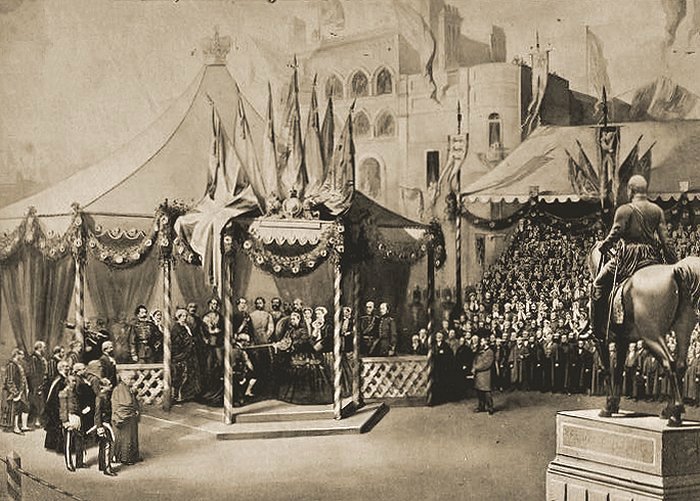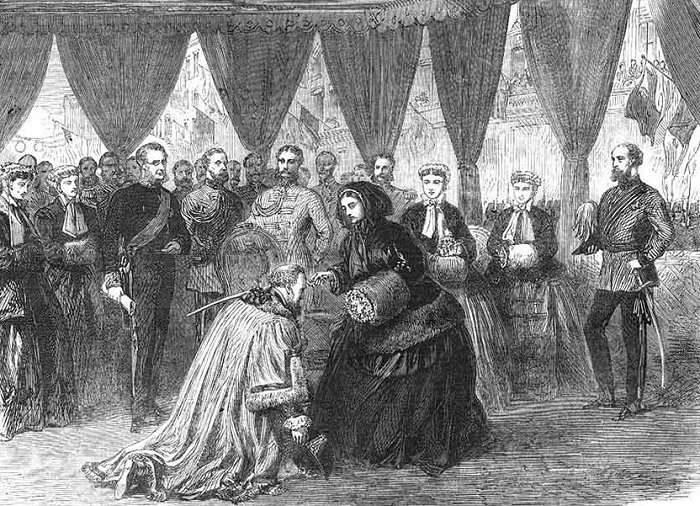During the occurrence of events recorded in previous pages, about two thousand fortunate holders of tickets to witness the ceremony of unveiling the Statue, had taken their seats in the pavilion; this was an elegant structure, erected in front of the statue, and furnished and decorated by Mr. Banting, the Court upholsterer. Its sides were open, except from the crimson drapings, which were looped up with wide openings, and the white roses with which it was decked on every side, except at the top, where pink roses were adopted, showed well on the rich crimson ground. The Royal crown which surmounted the dome-shaped roof, was very fine, and the trophy of flags around the Royal arms in front equally effective. Opposite to the Royal arms were those of the borough, and at each pole trophies of flags looked exceedingly gay. The whole of the floor around the statue was covered with crimson cloth, and it was hid from view by a square arrangement of national colours fixed on a frame so as to enable them to be lowered by a single movement. Down Darlington Street, the eye caught a long succession of festoons and banners. On each side the entrance to the pavilion a company of the Thirty-ninth Regiment, from Manchester, drew up as a guard of honour.
At a few minutes past one the signal of the Queen's arrival at the Station was given, the bells of St. Peter's struck up a joyous peal, and the spectators raised a hearty cheer. Expectation was now getting to fever heat, the guard presented arms, and every mounted policeman who passed was looked upon as the first of the vanguard of the procession. Soon the Staffordshire Yeomanry, which was represented by the Wolverhampton, Himley, Walsall, and Lichfield troops, and under the command of Colonel Lord Bagot and Major Thorneycroft, was seen ascending Darlington Street. At forty minutes past one they reached the back of the pavilion, and the members of the Town Council in their robes soon took their places in the pavilion to the left of the throne; whilst the Bishop took up a place to the right of the throne, as did the members for the borough, the Recorder, the Mayor's Chaplain, the Town Clerk, the Clerk of the Peace, and Aldermen Ironmonger, Underhill, Fowler, and Hawksford. The Lord Lieutenant and the Countess of Lichfield, the Earl of Derby, General Grey, Major-General Sir Thomas Biddulph, K.C.B., the Ladies in Waiting, and Maid of Honour to the Queen, Lord Alfred Paget (Clerk Marshal), etc., occupied the pavilion, and all was excitement when the Royal carriage stopped and Her Majesty alighted, with Prince and Princess Christian, and Princess Louise. The spectators rose and cheered with great enthusiasm, and Her Majesty advanced and bowed again and again, many, many times, with an empressement of courtesy, and a gratified look that could leave no doubt how highly she appreciated the reception awarded to her. The band played "God Save the Queen," and again and again were the plaudits renewed, and ever as they were did Her Majesty bow her acknowledgments. The Queen carried a beautiful bouquet and Princess Christian wore a dress of alternate stripes of blue and black.
Princess Louise wore a light puce dress with brown stripes, and each carried an elegant bouquet. The Princesses and the Prince stood to the left of the Queen. When all had taken their places and order was restored, the Bishop of Lichfield offered up a prayer. He proceeded to repeat the Lord's Prayer, in which the assembly fervently joined. The Recorder then read the following address which he had prepared, and which was beautifully illuminated and impressed with the Corporate Seal. To the Queen’s most excellent Majesty. "May it please Your Majesty, Your Majesty's faithful subjects, the Mayor, Aldermen, and Burgesses of Wolverhampton, crave permission to offer to Your Majesty their humble thanks for your Majesty's gracious condescension in thus honouring this borough with Your Royal Presence. The inhabitants of the surrounding districts of every class and degree, unequal in their fortunes, but equals in their loyalty also assemble here today to present their homage to Your Majesty, our beloved and gracious Sovereign. Inspired by feelings of profound devotion to III your Majesty's person, family, and throne, we presume to approach Your Majesty, and each and all of us most heartily bid your Majesty welcome. We ask your Majesty's permission to welcome also their Royal Highnesses the Prince and Princess Christian, and Her Royal Highness the Princess Louise, whose affectionate and dutiful attendance on Your Majesty has obtained for us the distinguished honour of the presence of their Royal Highnesses. We pray that your Majesty will deign to honour with your gracious approval, our earnest though inadequate attempt to testify our devotion to the memory of our late revered Prince, your Majesty's beloved and lamented Consort. We desire today, and in this place, to acknowledge and commemorate the debt of gratitude we owe to His Royal Highness. Dwelling in a district of Your Majesty's dominions where the resources of science are constantly required to develop the productions of nature and adapt them for the use and benefit of man; where art is ever striving to add grace and beauty to material form, and where the necessities of a vast industrial population demand incessant efforts to ameliorate their physical condition, to educate their minds, and to teach them moral and religious truth, we have felt it to be our duty, as it has been our delight, to erect this Statue of His Royal Highness, and thereby transmit to posterity a faithful representation of that Illustrious Prince who, promoting science by his judicious patronage, and art by his enlightened precepts, also incited all men to all works of Christian duty by the force of his beneficent example. We now humbly pray Your Majesty to unveil this Statue, that henceforth Your Majesty's loving subjects in this place may have ever present among them the image of the good Prince Consort, who, although prematurely taken away from us, still lives, and will ever live, in the imperishable remembrance of his virtues. May God preserve Your Majesty, and send Your Majesty health, peace, and consolation. Given under the Corporate Seal of the Borough of Wolverhampton, this 30th day of November, 1866." John Morris, Mayor. E. J. Hayes, Town Clerk The Address having been read by the Recorder, was handed by the Mayor to Her Majesty, which she was graciously pleased to accept. His Worship was then standing to the Queen's right, and Her Majesty turning, spoke to the Earl of Derby, who communicated to the Mayor Her Majesty's intention to confer upon him the honour of knighthood. His Worship, attired in court dress and official robes, promptly obeyed the command, and kneeling on one knee, made the usual obeisance, when Lord Derby immediately handed Her Majesty a sword borrowed from Lord Alfred Paget, with which the "accolade " was bestowed on the kneeling Mayor, and he thereupon rose up Sir John Morris. The action was observed by the spectators, who, as well as the Mayor himself, seemed to be taken entirely by surprise; but the moment the intention of Her Majesty became apparent, a cheer rang through the pavilion which was fairly deafening, and was heartily echoed by the crowd outside, attesting the gratification felt at the honour thus conferred on the town and its Chief Magistrate. The dignity and grace with which the Mayor received the honour thus worthily conferred, was the subject of general remark.
Sir John then presented in succession Mr. C. P. Villiers, M.P., Mr. T. M. Weguelin, M.P., the Recorder, the Town Clerk, the Clerk of the Peace, Aldermen Ironmonger, Fowler, the Mayor's Chaplain, Aldermen G. L. Underhill and Hawksford; these, as they were presented, bowed and passed the front of the pavilion to the left side of the Queen. Her Majesty then signified her pleasure that the Statue should be unveiled, and Mr. Thornycroft, the sculptor, drawing a cord, the colours surrounding it gracefully fell, and the Royal Standard gradually ascended a staff in the centre of the pavilion. The expression of Her Majesty's countenance, as the excellent likeness of the Prince came into view, betrayed her emotion, and the feeling of the assembly, until now restrained, gave vent, and one exciting enthusiastic cheer expressed the approval of the assemblage. Her Majesty, touched by the evident feeling of the spectators, bowed repeatedly, and when the entire figure appeared undraped she left the pavilion, and, accompanied by the Princesses, Prince Christian, and the Mayor, walked round the statue. Arriving at the further end of the arena, she noticed Mr. Thornycroft, the sculptor, to whose chisel Wolverhampton is indebted for this artistic gem, and calling him to her, in a. few words she expressed heir gratitude to him for his noble work, and her satisfaction at the manner in which the memory of the Prince Consort had been honoured at Wolverhampton. Again she was cheered, again she bowed low her acknowledgments, and spoke with animation to Mr. Villiers as she returned to the dais. Turning to those who stood behind her; the Queen spoke with manifestly gratified interest to the Earl of Lichfield, and conversed with the Mayoress and several persons. She remained on the spot for about twenty minutes, and as her carriage drew up for her return, the cheers broke out afresh, and she returned to the font, bowing many times to all parts of the audience. |








